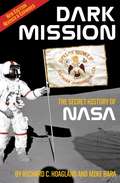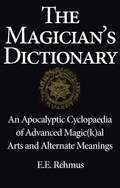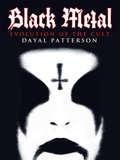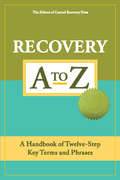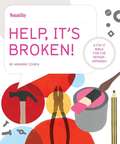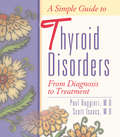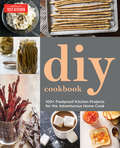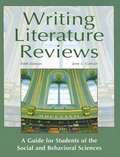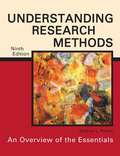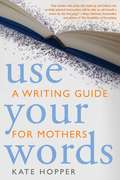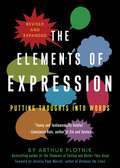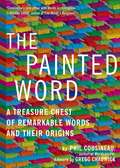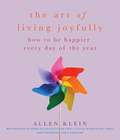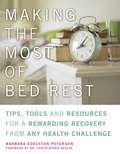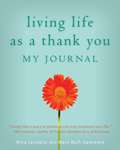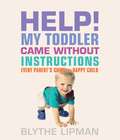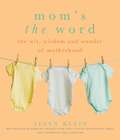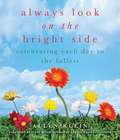- Table View
- List View
Dark Mission
by Richard C. Hoagland Mike BaraThe New York Times bestseller about the strange history of NASA and its cover-ups regarding its origins and extraterrestrial architecture found on the moon and Mars is even more interesting in its new edition.Authors Richard C. Hoagland and Mike Bara include a new chapter about the discoveries made by ex-Nazi scientist and NASA stalwart Wernher von Braun regarding what he termed "alternate gravitational solutions," or the rewriting of Newtonian physics into hyperdimensional spheres.
The Magician's Dictionary
by Edward E. RehmusUnlike most occult teaches, E.E. Rehmus doesn't mince words. He defines them. His Magician's Dictionary picks up where all other occult reference works leave off -- at the dawn of the apocalypse.
Black Metal
by Dayal PattersonFeaturing a wealth of new interviews with the genre's most central figures, Black Metal: Evolution of the Cult offers the most comprehensive guide yet to the most controversial form of extreme metal. From the pioneers of the early '80s to its fiery rebirth in Scandinavia through to today's diverse groups, this epic analysis captures the movement's development in unparalleled depth.
Recovery A to Z
by The Editors of Central Recovery PressRecovery A to Z (Second Edition) is the perfect reference for anyone in the twelve-step community. Contains useful and relevant meeting and fellowship etiquette. Loaded with FAQs and general facts regarding various twelve-step recovery programs. User-friendly format with definitions of words, phrases, and slogans common to the community. Updated resource listing appeals to an even broader audience.
Help, It's Broken! A Fix-it Bible for the Repair Impaired
by Arianne CohenNo matter where you live and whether you rent or own, one day you'll wake up in the morning and something will be broken. This book will come in handy to avoid panic and home repair disasters because a good reference guide is just what you need when there's a geyser in your living room. Count on this manual to tell you what to do or who to call to get the mess fixed.This useful book includes chapters on: Walls, Doors, Windows and Floors; Electricity; Appliances; Plumbing; Heat and Ventilation; Pests; Frugal Fixing and more. Each section is illustrated and explains the basics of how things operate before detailing how to fix them in a few easy steps. It also teaches you not only how to fix things yourself but also how to get someone who knows what they're doing to fix things for you and what questions to ask. This quick and informative guide can save you thousands of dollars and a lot of hassle. From unclogging drains to expelling rodents, from repairing stained carpet to fixing your dishwasher, you can depend on this book in any number of household catastrophes. Even if you can barely tell a nut from a bolt, Help! It's Broken is your quick reference guide for all home-repair solutions. Consider it a toolbox essential.
A Simple Guide to Thyroid Disorders: From Diagnosis to Treatment
by Scott Isaacs Paul Ruggieri Jack Allen KuslerDo You Have a Thyroid Disorder? If your doctor has told you that you have a thyroid disorder, perhaps you feel some relief in having pinpointed the source of your troublesome symptoms. As you may know, thyroid ailments often elude a diagnosis since they may mimic other illnesses. Now that you have a diagnosis, becoming informed will help you receive better health care. The authors, specialists in thyroid treatment, can help you understand both the complex function of your thyroid and how your disorder can best be treated. In A Simple Guide to Thyroid Disorders, they take special care to lay out the basics in a reader-friendly way. Among the topics they discuss: · medical tests you need to diagnose thyroid problems · hypothyroidism...symptoms and treatment · hyperthyroidism...symptoms and treatment · coping with emotional highs and lows · dealing with thyroid-related weight problems · medications and surgeries for thyroid disorders · thyroid nodules and cancers A Simple Guide to a Complex Disorder
The Do-It-Yourself Cookbook: Can It, Cure It, Churn It, Brew It
by The Editors at America's Test KitchenTrust the America&’s Test Kitchen experts to guide you through more than 100 foolproof kitchen DIY projects—from pickling and canning to home-brewing Why buy it when you can make it? Pantry Staples: For the freshest, best results, make your own ketchup, hot sauce, and vanilla extract. For the adventurous, there's sriracha, harissa, and wine vinegar. Jams and Jellies: Preserve the seasons with orange marmalade, strawberry jam, and apple butter, while wine jelly and bacon jam are great year-round options. Pickled Favorites: Get your pickle fix with classics like bread-and-butters and sour dills, plus test kitchen favorites like dilly beans, giardiniera, and kimchi. The Dairy Best: Making fresh cheeses like ricotta and goat cheese, churning butter, preparing yogurt, and even making soy milk (for tofu) are simpler than you think. Charcuterie at Home: From artisanal pancetta, prosciutto, pâtés, and terrines to everyday favorites like bacon, chorizo, and beef jerky, our recipes have the carnivore covered. Snacks and Sweets: Make store-bought favorites like rich buttery crackers, marshmallows, and graham crackers fresher and better. Or take the fancier route with lavash crackers, grissini, salted caramels, and chocolate-hazelnut spread. Beverages: Stock your fridge with root beer, ginger beer, and cold-brew coffee. Stock your bar with sweet vermouth, cocktail bitters, and tonic water. Plus, our IPA beer recipe is ideal for first-time home brewers.
Writing Literature Reviews: A Guide for Students of the Social and Behavioral Sciences
by Jose L. GalvanThis easy-to-follow guide instructs students in the preparation of literature reviews for term projects, theses, and dissertations. There are numerous examples from published literature reviews that illustrate the guidelines discussed in this text. New to this edition: Most of the examples have been updated with material from recently published research. Also new: Seven new model literature reviews for discussion and evaluation have been added. Guides students in the preparation of literature reviews for term projects, theses, and dissertations. Chapters are conveniently divided into easy-to-follow guidelines, sequential steps, or checklists. Numerous examples throughout the book show students what should and should not be done when writing reviews. Emphasizes critical analysis of reports of empirical research in academic journals-making it ideal as a supplement for research methods courses. This book makes it possible for students to work independently on a critical literature review as a term project. Nine model literature reviews at the end of the book provide the stimulus for homework assignments and classroom discussions. The activities at the end of each chapter keep students moving toward their goal of writing a polished, professional review of academic literature. New to this edition: Most of the examples have been updated with material from recently published research. Also new: Seven new model literature reviews for discussion and evaluation have been added.
Understanding Research Methods: An Overview of the Essentials (Ninth Edition)
by Mildred L. PattenUnderstanding Research Methods provides an overview of basic research methods.The updated text provides a detailed overview of all the important concepts traditionally covered in a research methods class. The numerous examples and large number of exercises help students master the material.
Use Your Words
by Hope Edelman Kate HopperUSE YOUR WORDS introduces the art of creative nonfiction to women who want to give written expression to their lives as mothers. Written by award-winning teacher and writer, Kate Hopper, this book will help women find the heart of their writing, learn to use motherhood as a lens through which to write the world, and turn their motherhood stories into art. Each chapter of USE YOUR WORDS focuses on an element of craft and contains a lecture, a published essay, and writing exercises that will serve as jumping-off points for the readers' own writing. Chapter topics include: the importance of using concrete details, an overview of creative nonfiction as a genre, character development, voice, humor, tense and writing the "hard stuff," reflection and back-story, structure, revision, and publishing. The content of each lecture is aligned with the essay/poem in that chapter to help readers more easily grasp the elements of craft being discussed. Together the chapters provide a unique opportunity for mother writers to learn and grow as writers.USE YOUR WORDS takes the approach that creative writing can be taught, and this underscores each chapter. When students learn to read like writers, to notice how a piece is put together, and to question the choices a writer makes, they begin to think like writers. When they learn to ground their writing in concrete, sensory details and begin to understand how to create believable characters and realistic dialogue, their own writing improves. USE YOUR WORDS reflects Kate's style as a teacher, guiding the reader in a straightforward, nurturing, and passionate voice. As one student noted in a class evaluation: "Kate is a born writer and teacher, and her enthusiasm for essays about motherhood and for teaching the nuts and bolts of writing so that ordinary mothers have the tools to write their stories is a gift to the world. She is raising the value of motherhood in our society as she helps mothers build their confidence and strengthen their game as writers."
Use Your Words: A Writing Guide for Mothers
by Kate HopperUSE YOUR WORDS introduces the art of creative nonfiction to women who want to give written expression to their lives as mothers. Written by award-winning teacher and writer, Kate Hopper, this book will help women find the heart of their writing, learn to use motherhood as a lens through which to write the world, and turn their motherhood stories into art. Each chapter of USE YOUR WORDS focuses on an element of craft and contains a lecture, a published essay, and writing exercises that will serve as jumping-off points for the readers' own writing. Chapter topics include: the importance of using concrete details, an overview of creative nonfiction as a genre, character development, voice, humor, tense and writing the "hard stuff," reflection and back-story, structure, revision, and publishing. The content of each lecture is aligned with the essay/poem in that chapter to help readers more easily grasp the elements of craft being discussed. Together the chapters provide a unique opportunity for mother writers to learn and grow as writers. USE YOUR WORDS takes the approach that creative writing can be taught, and this underscores each chapter. When students learn to read like writers, to notice how a piece is put together, and to question the choices a writer makes, they begin to think like writers. When they learn to ground their writing in concrete, sensory details and begin to understand how to create believable characters and realistic dialogue, their own writing improves. USE YOUR WORDS reflects Kate's style as a teacher, guiding the reader in a straightforward, nurturing, and passionate voice. As one student noted in a class evaluation: "Kate is a born writer and teacher, and her enthusiasm for essays about motherhood and for teaching the nuts and bolts of writing so that ordinary mothers have the tools to write their stories is a gift to the world. She is raising the value of motherhood in our society as she helps mothers build their confidence and strengthen their game as writers."
The Elements of Expression
by Arthur Plotnik Jessica MorellMore than ever in this completely updated edition, The Elements of Expression helps word users "light up the cosmos or the written page or the face across the table" as they seek the radiance of expressiveness-the vivid expression of thoughts, feelings, and observations.Nothing kills radiance like the murky, generic language dominating today's talk, airwaves, and posts. It tugs at our every sentence, but using it to express anything beyond the ordinary is like flapping the tongue to escape gravity. The Elements of Expression offers an adventurous and inspiring flight into words that truly share what's percolating in our minds. Here writers, presenters, students, bloggers-even well intentioned "Mad Men"-will discover language to convey precise feelings, move audiences, delight and persuade.No snob or scold, the acclaimed word-maven Arthur Plotnik explores the full range of expressiveness, from playful "tough talk" to finely wrought literature, with hundreds of rousing examples. Confessing that we are all "like a squid in its ink" when first groping for luminous expression, he shines his amiable wit on the elements leading, ultimately, to language of "fissionable intensity."
The Elements of Expression: Putting Thoughts into Words
by Arthur PlotnikMore than ever in this completely updated edition, The Elements of Expression helps word users "light up the cosmos or the written page or the face across the table" as they seek the radiance of expressiveness--the vivid expression of thoughts, feelings, and observations. Nothing kills radiance like the murky, generic language dominating today's talk, airwaves, and posts. It tugs at our every sentence, but using it to express anything beyond the ordinary is like flapping the tongue to escape gravity. The Elements of Expression offers an adventurous and inspiring flight into words that truly share what's percolating in our minds. Here writers, presenters, students, bloggers--even well intentioned "Mad Men"--will discover language to convey precise feelings, move audiences, delight and persuade. No snob or scold, the acclaimed word-maven Arthur Plotnik explores the full range of expressiveness, from playful "tough talk" to finely wrought literature, with hundreds of rousing examples. Confessing that we are all "like a squid in its ink" when first groping for luminous expression, he shines his amiable wit on the elements leading, ultimately, to language of "fissionable intensity."
The Painted Word
by Phil CousineauTo untangle the knot of interlocking meanings of these painted words, logophile and mythologist Phil Cousineau begins each fascinating word entry with his own brief definition. He then fills it in with a tint of etymology and a smattering of quotes that show how the word is used, ending with a list of companion words. The words themselves range from commonplace - like biscuit, a twice-baked cake for Roman soldiers - to loanwords including chaparral, from the Basque shepherds who came to the American West; words from myths, such as hector; metamorphosis words, like silly, which evolved holy to goofy in a mere thousand years; and words well worthy of revival, such as carrytale, a wandering storyteller. Whether old-fangled or brand new, all the words included in The Painted Word possess an ineffable quality that makes them luminous.
The Painted Word: A Treasure Chest of Remarkable Words and Their Origins
by Phil CousineauTo untangle the knot of interlocking meanings of these painted words, logophile and mythologist Phil Cousineau begins each fascinating word entry with his own brief definition. He then fills it in with a tint of etymology and a smattering of quotes that show how the word is used, ending with a list of companion words. The words themselves range from commonplace -- like biscuit, a twice-baked cake for Roman soldiers -- to loanwords including chaparral, from the Basque shepherds who came to the American West; words from myths, such as hector; metamorphosis words, like silly, which evolved holy to goofy in a mere thousand years; and words well worthy of revival, such as carrytale, a wandering storyteller. Whether old-fangled or brand new, all the words included in The Painted Word possess an ineffable quality that makes them luminous.
The Art of Living Joyfully
by Sark Allen KleinAllen Klein is a motivational speaker and author who believes strongly in the way words can influence how we feel mentally, physically, and spiritually. In this day of tweeting, texting, cyberspeak and the non-language of E-mail, the written and spoken word has the power to touch our hearts and lift our spirit that is extraordinary.In this The Art of Living Joyfully, Jollytologist Allen Klein presents a compendium of advice and plain common sense comprising a guide to good cheer. This wonderful collection of quips, quotes and instruction comes from a variety of people and from all eras of history. Dividing the books thematically, covering such topics as Friendship, Laughter, Beauty, Nature, Faith, and more, this is a book to cherish for oneself and to give as a heartfelt gift.HENRY DAVID THOREAU on Friendship: "The most I can for my friend is simply to be his friend,"WILLIAM SHAKESPEARE on Laughter: "A light heart lives long."RALPH WALDO EMERSON on Happiness: "Happiness is a perfume which you cannot pour on someone without getting some on yourself."SOPHOCLES on Love: "One word frees us of all the weight and pain of life: That word is love."MARTIN LUTHER on Nature: "Our Lord has written the promise of resurrection, not in books alone but in every leaf of springtime."From yesteryear to yesterday to today; from the famous to the little known; on subjects that touch our lives every day in every way, the selection of quotes in THE ART OF LIVING JOYFULLY offers insight and inspiration to help you and those you care about feel good about themselves and life.
Making the Most of Bed Rest
by Barbara Edelston PetersonFor the more than one million people who face an extended period of bed rest every year, this practical and reassuring guide turns recuperation into a productive and rewarding experience. Forced to spend months in bed during her first pregnancy, author Barbara Edelston Peterson knows what it takes to triumph over a drawn-out confinement. Find out how to transform a bed into "Command Central" - beat loneliness by staying connected to the world via family, friends, and the Internet; plan weekly and daily schedules of tasks and events; start personal projects like reading, learning a craft, or volunteering; create special quality time in bed with your children; and maintain a warm relationship with your partner. With firsthand accounts of people who have successfully come through a long-term confinement, plus helpful appendices offering sources for more information and support, Making the Most of Bed Rest transforms confinement into productive and fulfilling contentment.
Making the Most of Bed Rest: Tips, Tools, and Resources for a Rewarding Recovery from Any Health Challenge
by Barbara PetersonFor the more than one million people who face an extended period of bed rest every year, this practical and reassuring guide turns recuperation into a productive and rewarding experience. Forced to spend months in bed during her first pregnancy, author Barbara Edelston Peterson knows what it takes to triumph over a drawn-out confinement. Find out how to transform a bed into "Command Central" -- beat loneliness by staying connected to the world via family, friends, and the Internet; plan weekly and daily schedules of tasks and events; start personal projects like reading, learning a craft, or volunteering; create special quality time in bed with your children; and maintain a warm relationship with your partner. With firsthand accounts of people who have successfully come through a long-term confinement, plus helpful appendices offering sources for more information and support, Making the Most of Bed Rest transforms confinement into productive and fulfilling contentment.
Living Life as a Thank You Journal
by Mary Beth Sammons Nina LesowitzBuilding upon the foundational wisdom of the best-selling Living Life as a Thank You Nina Lesowitz and Mary Beth Sammons have created a journal filled with life-changing practices and encouraging advice to take readers through a process of self-transformation and personal growth. The friendly format not only provides readers with tried and true thank you techniques and practices, but also allows them to take part in creating their own.The act and power of gratitude has a direct effect on our lives on a physical, spiritual, mental and emotional level. Studies have shown that living life with appreciation leads to a greater sense of well-being and happiness. The secret to a happy and fulfilled life may rely on focusing on all the good, rather than what is lacking or not going well at the moment. Living Life as a Thank You: My Journal is a toolkit for this transformation.
Living Life as a Thank You Journal
by Nina LesowitzBuilding upon the foundational wisdom of the best-selling Living Life as a Thank You Nina Lesowitz and Mary Beth Sammons have created a journal filled with life-changing practices and encouraging advice to take readers through a process of self-transformation and personal growth. The friendly format not only provides readers with tried and true thank you techniques and practices, but also allows them to take part in creating their own. The act and power of gratitude has a direct effect on our lives on a physical, spiritual, mental and emotional level. Studies have shown that living life with appreciation leads to a greater sense of well-being and happiness. The secret to a happy and fulfilled life may rely on focusing on all the good, rather than what is lacking or not going well at the moment. Living Life as a Thank You: My Journal is a toolkit for this transformation.
Help! My Toddler Came Without Instructions
by Dr John Duffy Blythe LipmanRaising children is a serious business, especially in this era of two working parents with jam-packed schedules. A helping hand can make all the difference. Nationally known parenting expert Blythe Lipman is on a mission to help parents, offering hundreds of practical tips with a dash of humor. Go from stressed-out, overwhelmed and exhausted to melt-down free and mellow! The purpose of Help! My Toddler Came Without Instructions is to provide parents with quick solutions to help with those hair-raising toddler issues. When some new "toddler troubles" arise, grab the book, find the solution and you'll be back in control of your out-of-control child. Topics include sleeping (ways to transition from crib to bed, naps, creating a friendly sleep environment and nightly rituals and routines), potty training (age discussion, type of potty to use, fears, underwear, charts and issues), and fears (night terrors, stranger anxiety, the dark, monsters and separation anxiety).
Help! My Toddler Came Without Instructions: Practical tips for Parenting a Happy One, Two, Three and Four Year Old
by Blythe LipmanRaising children is a serious business, especially in this era of two working parents with jam-packed schedules. A helping hand can make all the difference. Nationally known parenting expert Blythe Lipman is on a mission to help parents, offering hundreds of practical tips with a dash of humor. Go from stressed-out, overwhelmed and exhausted to melt-down free and mellow! The purpose of Help! My Toddler Came Without Instructions is to provide parents with quick solutions to help with those hair-raising toddler issues. When some new "toddler troubles" arise, grab the book, find the solution and you'll be back in control of your out-of-control child. Topics include sleeping (ways to transition from crib to bed, naps, creating a friendly sleep environment and nightly rituals and routines), potty training (age discussion, type of potty to use, fears, underwear, charts and issues), and fears (night terrors, stranger anxiety, the dark, monsters and separation anxiety).
Mom's the Word
by Allen Klein Kate HopperHeartwarming and humorous, this tribute to moms of the world gathers the best things anyone ever said about motherhood. From Dolly Parton to Dear Abby to delightful mother daughter duos such as Goldie Hawn and Kate Hudson, women (and a few men) crack wise on the subject of the center of every family, mommie dearest! Mom's the Word celebrates all motherhood with wise and witty words from the famous (Oprah Winfrey: "Mothers are really the true spiritual leaders.") and the funny (Erma Bombeck: "In general, my children refuse to eat anything that hasn't danced on television."). Also included are as well as thoughts that are meaningful (Jewish proverb: "God could not be everywhere and therefore he made mothers.") and memorable (Nora Ephron: "If pregnancy were a book, they would cut the last two chapters.").
Mom's the Word: The Wit, Wisdom, and Wonder of Motherhood
by Allen Klein Kate HopperHeartwarming and humorous, this tribute to moms of the world gathers the best things anyone ever said about motherhood. From Dolly Parton to Dear Abby to delightful mother daughter duos such as Goldie Hawn and Kate Hudson, women (and a few men) crack wise on the subject of the center of every family, mommie dearest! Mom's the Word celebrates all motherhood with wise and witty words from the famous (Oprah Winfrey: "Mothers are really the true spiritual leaders.") and the funny (Erma Bombeck: "In general, my children refuse to eat anything that hasn't danced on television."). Also included are as well as thoughts that are meaningful (Jewish proverb: "God could not be everywhere and therefore he made mothers.") and memorable (Nora Ephron: "If pregnancy were a book, they would cut the last two chapters.").
Always Look on the Bright Side
by Allen Klein Steve RizzoWe often think of celebrations as centering around special occasions, like Birthdays, Christmas, or other holidays. But there is no need to wait for those times. Everyday is a cause for celebration. The very fact that you are alive, the wondrous world around you, and the special people in your life are all reasons to rejoice.That's what this book is all about. Over 500 suggestions for living life to the fullest. A compendium of "glass half full" common sense, these witty and wise words from both the rich and famous, as well as the not-so-rich and the not-so-famous, will, I hope, inspire you to make every day a special day.Pianist Artur Rubinstein once said, "To be alive, it's all a miracle." Yes indeed, it is all a miracle, and all a cause for celebration.
